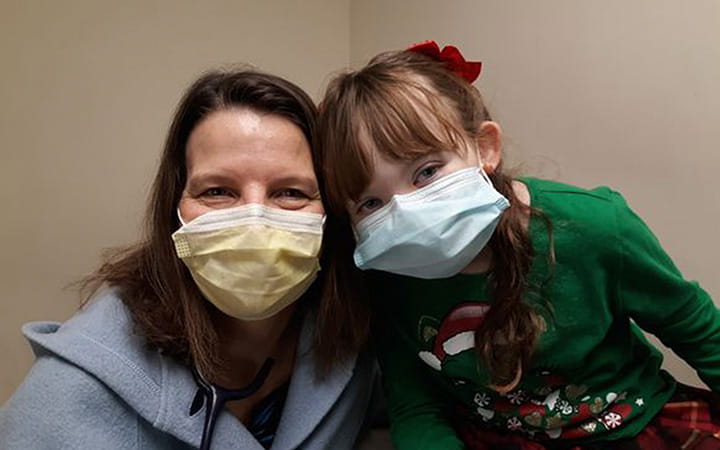Using Biofeedback for Relief from Chronic Constipation in Children
December 22, 2020
 University Hospitals Rainbow Babies & Children'sExperts in Children's Health
University Hospitals Rainbow Babies & Children'sExperts in Children's Health

Nine-year-old Chloe Griffin has had gastrointestinal (GI) issues for most of her life. But when she started having chronic constipation about two years ago, her GI doctor referred her for biofeedback treatment with Mary Alice Dombrowski, APRN-CFNP, DNP.
Dombrowski uses biofeedback to help children and young adults ages 3 to 24. Her practice at UH Rainbow Babies & Children’s Hospital is one of the only in northeast Ohio to provide biofeedback therapy for chronic constipation, dyssenergic defecation and rectal prolapse. She also works closely with the urology team, as many children with urinary incontinence also have chronic constipation. Biofeedback can help patients gain control over muscle groups important for releasing urine and stool.
Using Biofeedback to Diagnose and Treat Constipation
“In Chloe’s case, the first step was to pinpoint the cause of her constipation by checking to see if her muscles were working correctly,” says Chloe’s mother, Tammy. “Mary Alice attached biofeedback sensors to the muscles near Chloe’s bottom and asked her to relax or contract the muscles to try to make animals move on a video screen. For Chloe, it was more like a game than a medical appointment.”
Through biofeedback, they learned that Chloe’s muscles were indeed working properly, but she wasn’t using them correctly to push stool out.
“Once we determined this, Mary Alice worked with Chloe over several sessions to teach her how to push the right way and for the right amount of time,” Tammy says. “It was a great way to show her how her muscles work, and it gave her a sense of control over her body. The treatment really helped.”
Treating Functional Constipation
Although Dombrowski treats patients with a wide range of issues, she says the most common condition she sees is functional constipation.
“These are kids who have the nerves and muscle necessary for passing stool, but have forgotten how to have a normal bowel movement and have become chronically constipated,” Dombrowski says. “It can be very difficult to break the cycle of chronic constipation with medication alone.”
This can occur when children hold their stool over a period of days or weeks. “After holding stool for so long, only liquid stool can come out, so they have constant fecal soiling,” Dombrowski says.
Most of the kids she sees have been having accidents for a long time, and don’t know what to do, she says.
“Giving more medicines doesn’t help because they need to relearn how to relax their muscles so they go to the bathroom,” Dombrowski says.
Two Types of Biofeedback
When Dombrowski first meets a patient, she talks with them about the type of biofeedback that will be best for them.
“We use two basic types of biofeedback,” she says. “The first type focuses on gaining more control and increasing strength of the pelvic floor muscles. This method uses external sensors and is appropriate for children of all ages. It really helps kids strengthen their pelvic floor muscles and gives them control over body, so it’s very empowering.”
The second type is called anal-rectal biofeedback. This involves painlessly inserting a very thin catheter into the anus. There is a small balloon on end of the catheter, which can be inflated to help kids regain the sensation of needing to go the bathroom and also practice the act of defecation.
“With this type of biofeedback, children can relearn how to coordinate their muscles to go the bathroom more easily,” Dombrowski says. “This is especially helpful for older children who feel they can no longer pass stool. Through biofeedback, they can see that they do have control over their body.”
With either type of biofeedback, the child is connected to a computer where they can watch how their muscles are working. They can do this either by playing video games and using those muscles to move characters or looking at a computer screen to see how their muscles relax and contract.
“Once they can see how their muscles are responding, I coach them through a series of exercises to help them use the muscles correctly,” Dombrowski says.
Relaxation and Hypnosis Techniques
Dombrowski also uses relaxation techniques, such as deep breathing, progressive muscle relaxation and guided relaxation. On occasion, she also uses hypnosis. She says these techniques are especially helpful for kids who have anxiety, which can make constipation worse.
“Mary Alice has done some hypnotherapy techniques with Chloe, and that’s also been helpful,” Tammy says. “She was having anxiety, so Mary Alice taught her to close her eyes and go to a happy place when she feels upset. The combination of relaxation and strengthening her muscles has really helped. And Chloe just loves Mary Alice. She’s been like an angel for us.”
When to Get Help
Dombrowski says if your child is having chronic constipation, fecal soiling of any type, or any fear of passing stool, it’s time to make an appointment. As a nurse practitioner, Dombrowski can also prescribe and manage medications for constipation, and she collaborates with other specialists to ensure all of the patient’s needs are being met.
Related Links
UH Rainbow Babies & Children’s Hospital is the only provider in Northeast Ohio that provides biofeedback therapy to treat urinary and defecation difficulties and functional constipation in children, teens and young adults. Learn more about biofeedback therapy at UH Rainbow or make an appointment today.
Tags: Children's Health, Constipation


